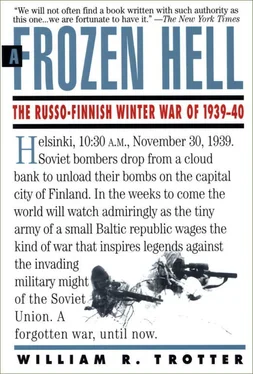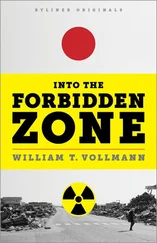Even to the more radical factions of the Finnish proletariat, the Kuusinen government looked exactly like what it was: a pathetic farce and a propaganda ploy of insulting crudeness. But having erected this puppet regime, the Soviets were reluctant to admit their folly by abandoning it upon the first snorts of derision from world opinion. And Stalin’s ultimate purpose for creating the Kuusinen government was not humorous in the least. When the world press condemned Russia for naked aggression against a smaller neighbor, the Kremlin could blandly reply that the Red Army was merely going to the requested aid of the “legitimate” Finnish government. Or, as Pravda crowed in its front-page paean to the Kuusinen inauguration: “only the Soviet Union, which rejects in principle the violent seizure of territory and the enslavement of nations, would agree to place its armed might at disposal, not for the purpose of attacking Finland or enslaving her people, but for securing Finland’s independence.”
The very existence of the Kuusinen regime posed a difficult obstacle in the way of any attempt to reopen negotiations; it prolonged the war, that much is certain, and probably, if indirectly, caused the deaths of thousands of men on both sides.
Tanner’s new government felt the impact almost immediately. He succeeded in placing the matter of Russia’s invasion before the League of Nations. In the debates that followed, the member states reacted in a curious way: the virulence of their condemnations rose in direct proportion to their physical distance from the Soviet Union. Argentina, for example, denounced Stalin in savage, Churchillian rhetoric. The Scandinavian nations, however, issued muted and diplomatic statements of principle. In rebuttal, the Soviet Union’s representative rose to object to the harsh language directed at his country. Why, Russia was not “at war” with Finland! How absurd! On the contrary, its relations with the legitimate Kuusinen government were, verifiably, the last word in cordiality and mutual trust!
In disgust, the democratic members of the League did the only thing in their power left to do; flexing what little muscle remained in that moribund congress, the League of Nations expelled the Soviet Union. It was not the sort of rebuke that Stalin was likely to lose sleep over.
CHAPTER 6
The Mannerheim Line
In the forest battles north of Lake Ladoga, the Finns beat the Russians by adopting a style of warfare different only in detail from the tactics that caused Braddock’s defeat in colonial America two centuries earlier. The invader was outmaneuvered and outfought by men defending their homeland, fighting in the style that was best suited to their native terrain—guerrilla tactics on a massive scale—and compensating for their numerical and technological inferiority with speed, daring, and economy of force. The image of the outnumbered but intrepid ski warrior that emerged from those victories became, in the minds of newspaper readers the world over, the most vivid and inspiring symbol of Finnish resistance. There wasn’t room in most people’s minds for any other.
But in some ways, the struggle for the Karelian Isthmus proved the Finns’ mettle even more than their sensational triumphs in the northern wilderness. The Isthmus gave little chance to exercise those guerrilla tactics; the restricted nature of the terrain created a classic and thoroughly conventional military situation: a heavily fortified line, its flanks protected by large bodies of water (at least until that water turned to ice), manned by stubborn defenders, being assaulted by a powerful and numerically superior attacker. The Finns would win or lose on the basis of their conventional, professional, military skills, the fiber of their discipline, the worthiness of their commanders—and above all else, on the depth and stubbornness of their sisu . That bristling little word was once the most famous Finnish idiom ever to become part of the outside world’s vocabulary. It can be translated as “guts” or “spunk” or “grit” or “balls,” or as a combination of all those words together. The word in Finnish has nuances that resist easy translation.
Largely to excuse the enormous losses they incurred during their frontal assaults against it, the Russians went to much trouble during the latter weeks of the war, and in all their published accounts of it since, to inflate the Mannerheim Line’s reputation to fantastic proportions. The usual claim was that it was “as strong as” or “stronger than” the Maginot Line. After the armistice, their propaganda trumpeted that the breaching of the Mannerheim Line was “a feat without parallel in the annals of war.” Naturally, while the fighting was going on, the Finns did nothing to discourage the enemy’s propaganda efforts on their behalf.
Since the war, however, Finnish historians have belittled the line’s strength perhaps too much, insisting that it was mostly just conventional trenches and log-covered dugouts and that the real strength of the Mannerheim Line was the sisu of the troops manning it.
The truth lies somewhere in between. It is still possible to get a firsthand impression of the strength of the line’s fortifications by examining the ruins of several of its blockhouses. These can be found within 100 meters of the main road between Viipuri and Leningrad, on the site of what used to be Summa village—that is to say, at the most critical and vulnerable point of the entire Finnish defense. The biggest and most elaborate bunkers, with the exception of the coast-defense forts on the gulf shore and on the coast of Ladoga, were located north of Summa, covering the Lähde road. These probably still exist, but they are far from any road that tourists normally travel, and the entire Isthmus is still considered a militarily sensitive area by the Russians. One would be well advised not to go wandering through the woods.
The surviving bunkers show signs of terrible damage—the author crawled around inside one that looked as though it had been beaten into the earth with a giant ball-peen hammer—but enough was left to draw some conclusions. First of all, these were not anything as big or elaborate as the multi-layered dinosaurs of the Maginot Line. They were, however, massive, thick, multi-chambered blockhouses; if manned by stubborn defenders, they would have been very tough to take and even harder to knock out with fire alone.
Just how strong was the line, then? Here, the researcher runs into considerable confusion. Every general who published a book about the Winter War gives a different estimate of the line’s strength. Mannerheim, in his Memoirs , states that the entire line contained only sixty-six “strong points,” of which about forty were too old or thin to withstand much modern artillery fire.
General Öhquist, distinguished commander of the Finnish Second Corps, which bore the brunt of the Isthmus fighting, offered a different breakdown of figures. From the Gulf of Finland to the Vuoksi Waterway, the line had ninety-three “strong points,” of which Öhquist judged forty-nine to be of inferior quality and durability; along the Vuoksi Waterway, north to Lake Ladoga, Öhquist counted some twenty-six “strong points,” all of them old, but many of them modernized in the months before the war.
Perhaps it depends on how one defines the term “strong point.” Mannerheim was apparently listing only those positions that were “strong” by the standards of 1939—bunkers made of reinforced concrete. Öhquist’s figures seem to include a number of the stronger field fortifications—log-roofed bunkers or elaborate earthworks. The Russians, for their part, added to the confusion by the flat claim that they captured more than “300 forts,” whatever that may mean; the total is exaggerated even if it includes the coastal defense works in the Koivisto sector, on the gulf islands, and those in the secondary defense line manned by the Finns after the Mannerheim Line was breached in February.
Читать дальше












